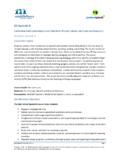Transcription of eLesson: Unconscious Bias
1 1 elesson : Unconscious bias Microsoft s Unconscious bias training and related materials are for your internal use only. Microsoft offers Unconscious bias training for informational purposes and as an additional resource you can use in your diversity training efforts. Microsoft makes no warranties, express or implied, regarding the training or its suitability for your particular organization. 2015 Microsoft 2 english Version Welcome course Introduction Welcome to the elesson : Unconscious bias . In this course , you'll deepen your understanding of Unconscious biases, how they influence behavior, and how they impact us all. You'll also learn numerous actions you can take to help counter bias in your own work environment. This course begins with a brief introduction to Unconscious bias . In the scenarios that follow, you'll explore bias and what you can do about it through video scenarios, interactive exercises and opportunities for reflection.
2 Understanding bias Unconscious bias Defined Unconscious bias is a quick and often inaccurate judgment based on limited facts and our own life experiences. These judgments can give individuals and groups both unearned advantage and unearned disadvantage in the workplace. People can be biased about just about anything not just things like gender, skin color, or age, but also things like communication style or what someone does in their free time. Unconscious bias is not intentional it's part of the lens through which we see the world. In our everyday lives, when people don't fit our internalized expectations, we can sometimes have difficulty seeing their talents, motivations, and potential clearly which can mean we interact with them less effectively. When we understand how biases influence our behavior, we can take action to create an inclusive culture one where everyone can contribute, innovate, and provide solutions that our customers love.
3 3 All People Are Biased It's important to understand that we all have Unconscious biases it's our brains' way of dealing with an overload of information. Brain researchers estimate the human mind takes in 11 million pieces of information per second through our senses. Out of those 11 million, how many pieces of information do you think our brain is consciously aware of each second? A. 40 B. 400 C. 4,000 D. 4 million Feedback: The answer is A. Our brain is consciously aware of only about 40 pieces of information per second. While we think we are being deliberate, rational, and thoughtful, our conscious thinking is actually a very small part of what drives our actions and judgments. No matter how well-meaning we are, we are all susceptible to bias . It's our brains' way of making sense of the flood of information that is coming at us constantly. How Biases Are Formed Biases are shortcuts our brain forms based on: our own experiences things other people tell us media portrayals 4 institutional influences other external influences When faced with situations or people that appear to fit into these "mental maps" our mind has created, we make a number of automatic associations.
4 Not surprisingly, our perceptions and assumptions based on these automatic associations are often incorrect. Because our Unconscious biases are so hidden from ourselves, it takes some work to disrupt them, but it can be done through active reflection and practicing inclusive behaviors. Doing this work benefits us, the people around us, and our business. Business Impact of bias vs. Diversity and Inclusion Unconscious bias can undermine our engagement, ability to innovate, and ability to understand our customers. This negatively impacts us as individuals and as a business. When we counter bias with inclusive behaviors, we increase our ability to: create innovative and relevant products and services excite our employees and customers extend our brand See the impact of bias vs. diversity and inclusion: Engagement Unconscious biases can result in some individuals being underutilized and unable to contribute fully.
5 When we encourage everyone's contributions, employees are more likely to be engaged, effective, and contribute to business outcomes. 5 This creates a better experience for everyone. Innovation When bias prevents us from hearing and considering diverse points of view, our ability to innovate is negatively impacted. Creating an inclusive environment helps us hear multiple points of view and maximize our potential to innovate. This leads to better products and solutions for customers. Understanding Our Customers When we foster an environment where employees are empowered to contribute their diverse experiences and perspectives, we better serve our diverse customers, including: Women Racial and ethnic minorities People with disabilities Lesbian, gay, bisexual, and transgender people People of all ages People in emerging markets around the world To be successful, we must understand these markets well enough to be an essential and exciting part of their lives.
6 Financial Results There is a tremendous financial upside to appealing to a diverse audience. On the next few screens, we'll look at some of our untapped potential in diverse and emerging markets. When we counter Unconscious bias through inclusive behaviors, it helps us reach these markets. 6 Financial Impact: Emerging Markets Did you know that the top 10 growth markets for tech device spending in 2015 are all in emerging economies? The countries shown at left are the top 10 markets (not shown in order). Match the three top growth markets to their projected market growth (2015 vs. 2014). Bangladesh $ Billion Brazil $ billion China $ billion Egypt India Indonesia Nigeria Pakistan Philipines Vietnam Feedback: India $ Billion China $ billion Nigeria $ billion When we can engage effectively with employees from different backgrounds and cultures, we can better serve these tech device markets.
7 If you d like to see the full ranking, see the source article on Stastita (via Gfk). 7 What This Means to Me Think of the people you feel comfortable with and work effectively with. o What is the reason for your comfort level and effective collaboration with these individuals? Now think of the people you feel less comfortable with or connect with less frequently. o What could you do to connect with these people? Do you value and actively seek diverse points of view? What could you do to better understand your internal and/or external customers? Scenario: "The Right Project Lead" Video 1 Mark: Right. So, I wanted to get everyone's input on the right person to lead the project, since Joe is moving across to the Zero base project. Now I think Cynthia is our best bet. She's a fast learner, and she's led on a similar project before. David: I've had limited interaction with her, but it's hard for me to picture her leading the team.
8 Laila: Well, I think .. Joe: I agree, I don't think she has a strong enough technical background. David: I'm not sure that she can give the time needed for this kind of project given her family situation. Aggressive timelines like this require someone's full attention. Joe: Two young children take a lot of looking after .. We don't want anyone having to leave early. 8 Mark: That doesn't necessarily mean you can't still work efficiently. Mine are a little older. Laila: You know, it's .. Joe: Being a project lead requires full focus. Mark: Laila, you were saying .. Laila: Joe, you were questioning Cynthia's technical background, but she has a PhD in Computer Engineering. Joe: Yes, but that's just an academic qualification. Laila: Oh, well I see a long list of qualifications here actually. What exactly are you looking for? Joe: What about Ravi? He's been with me since we created the application.
9 And if you're taking me off the project .. Mark: Because, I need you on the Zero Base project. Joe: I know, but he's got the experience and the expertise. David: But Ravi's in India .. we need someone who's available. A lot gets accomplished in random discussions in the hallway. Laila: And Ravi is so introverted. He has a different communication style .. you know how hard it is to get a word in edgewise at this company. Mark: That's true. It is difficult to communicate with him sometimes. His personality is suited to his role as head engineer. It just makes better use of his talent. How about Gerry? Laila: I like him. David: He reminds me of that hip hop 's his name? Laila: Why, because he's black? David: You know that's not what I mean. Because he's chill .. you know, uh .. laid back. Cool. Mark: Yeah, he has a different style. I mean I like him, he's fun .. but I can't 9 help feeling that he's too laid back.
10 What's he going to do when the project intensity increases? Joe: He hasn't been here long enough. His previous job was at a financial corporation. Mark: But he's got a strong application development background. Laila: And he would bring a fresh perspective .. Plus it would be nice to have somebody leading who's likeable. Joe: But would he keep up with the fast pace? Mark: So, all things considered, I think Cynthia is our best option. I really appreciate your taking the time to talk this through. Question: Identifying bias Which statements are true? Select all that apply. A. Technical understanding is important when leading a technical project. B. Cynthia's young children will make it harder for her to be fully committed to the project. C. Ravi's introverted nature makes him an unsuitable project leader. D. Gerry's relaxed demeanor would not serve this project's goals. Feedback: The only true statement is A.






